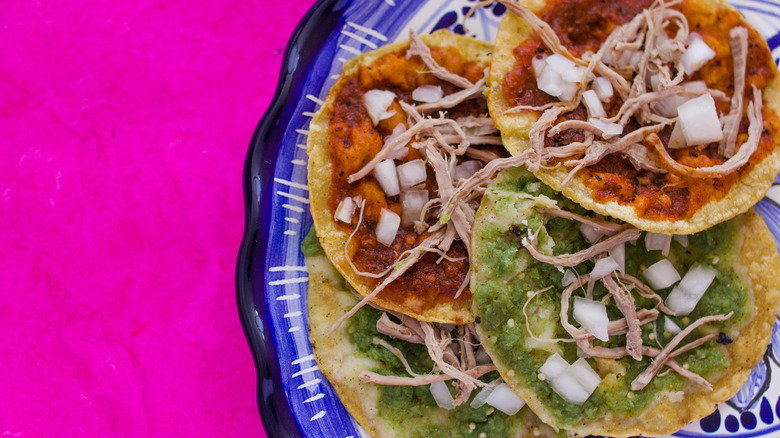Chalupa Vs Tostada: What's The Difference?
There's a bevy of delicious dishes in Mexican cuisine. In addition to the ever-welcome and ubiquitous taco, there's a whole kaleidoscope of presentations and flavors in foods like quesadillas, empanadas, burritos, chilaquiles, and nachos (which are authentically Mexican!). When dealing with the use of similar ingredients across multiple dishes, you're going to get a fair amount of conceptual overlap, and in Mexican food, a great example is chalupas versus tostadas. Since they can sometimes look alike, not everyone is clear on the difference.
So what sets one apart from the other? There are a few key distinctions between the two, from the shape of their shells (one is always flat, one is often boat-shaped) to the actual composition of those shells (one is made with fresh masa, one with a fried corn tortilla shell). Additionally, one is more of a snack while the other can be turned into a main course. Once you know what to look for, it's not hard to tell them apart at all.
Tostadas are wildly versatile
We don't quite know where the tostada originally came from in Mesoamerica (though we know it predates European contact), but the idea behind it is as simple as it is efficient. They were designed as a way to use corn tortillas that were just a bit past prime for tacos but were still somewhat pliable. They were originally dry-roasted, though the modern form is more typically deep-fried. Regardless, they're always flat and circular, with a thin, crispy texture that gives a crunch with every bite.
Think of a tostada as an open-faced taco, because essentially, that's what it is: A blank canvas onto which you might paint any number of toppings. Much like a taco, the sky is the limit for what you can put on a tostada. The same is true of their purpose, you can either have them as an appetizer or as a full meal. They're messy to eat because they're intended to be finger food; you're never supposed to crack that shell with a knife and fork.
Chalupas have a different texture
Chalupas can be flat and open-faced, and you can put pretty much anything on them. (This is where it gets confusing — when they are flat, they look very much like a tostada.) A chalupa can sometimes be shaped like an oblong little boat. (Which is exactly what "chalupa" means in Spanish — little boat). When a chalupa is shaped this way, it's one of the easiest ways to tell it apart from a tostada, which is always a flat, circular shell.
The texture is also different, as tostada shells are made from frying or dry-roasting yesterday's corn tortillas until they are very crispy, like a chip. Chalupas are typically made from softer masa dough, and they're usually fried fresh, in lard. They're still somewhat crispy (they're fried, after all), but they're also markedly softer and chewier. Unlike tostadas, chalupas are meant to be eaten purely as an appetizer or snack. Regardless of which one you're eating — you can be sure they're both delicious.


